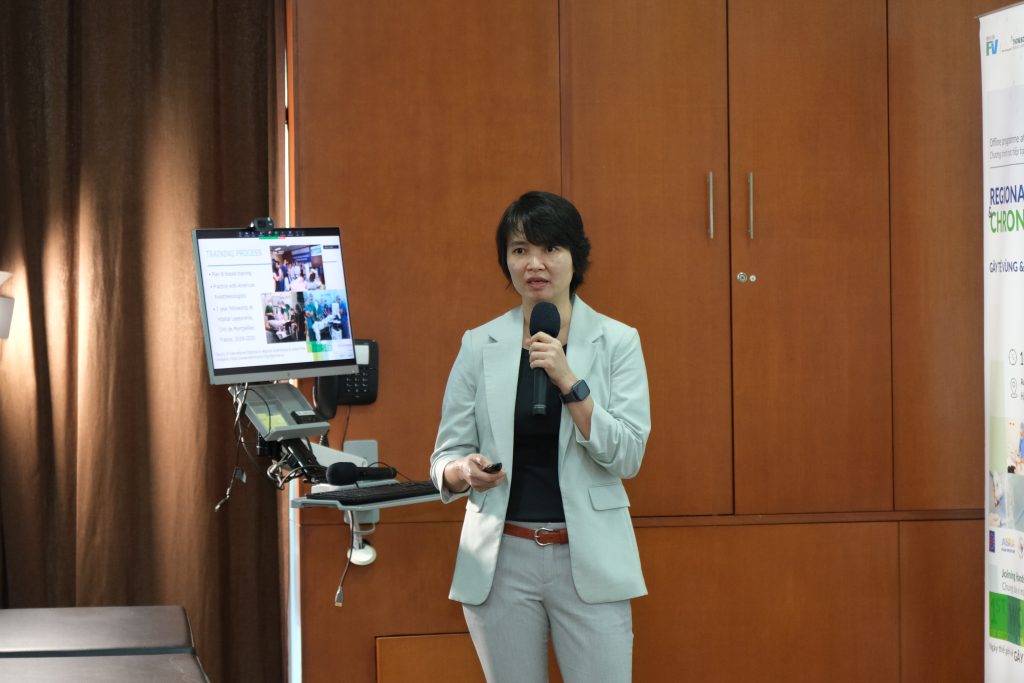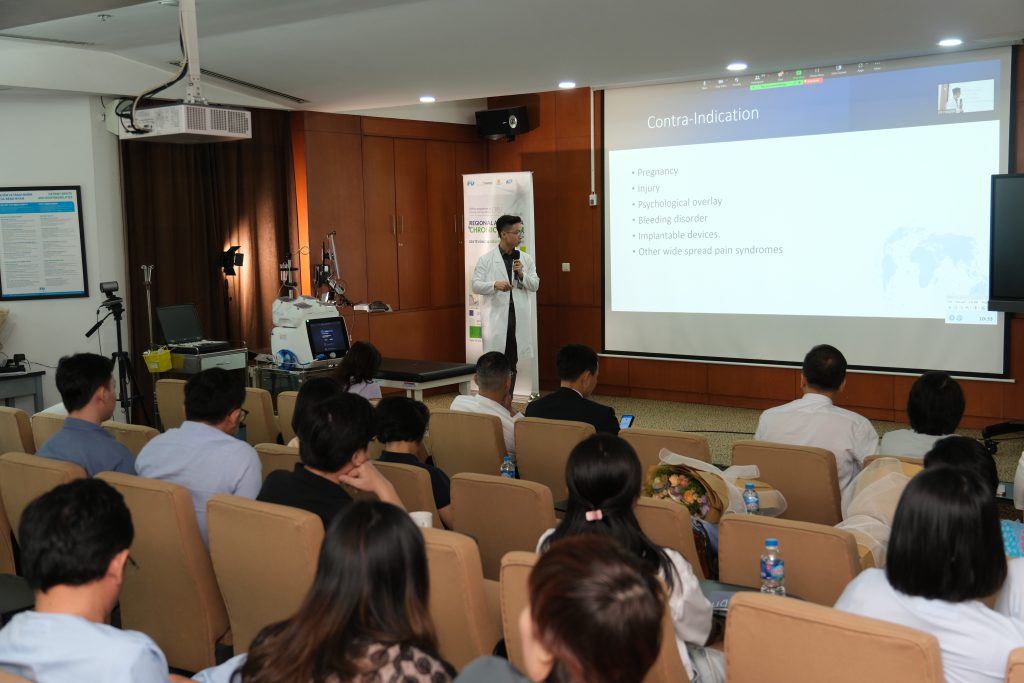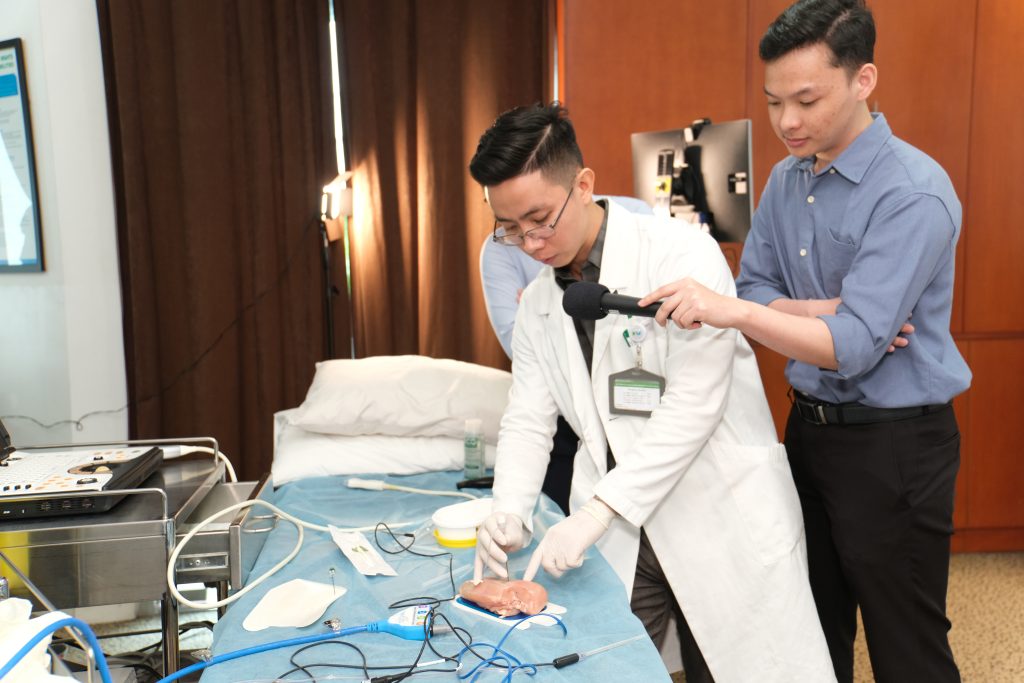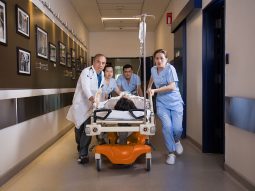On January 27th, more than 100 countries worldwide participated in the first World Day of Regional Anaesthesia & Pain Medicine. In Vietnam, FV Hospital collaborated with the Vietnam Society of Anaesthesiologists–SIMCAT Centre and three partner hospitals to organise a CME-certified conference themed “Joining Hands for a Pain-Free Future Worldwide.”
This specialised field has great potential to provide comprehensive care for patients.
Representing the organising committee, Cong Quyet Thang, MD, PhD, Chairman of the Vietnam Society of Anaesthesiologists, kicked off the conference by expressing gratitude to four hospital teams for their enthusiastic response to this special event. He also shared that the field of regional anaesthesia and pain management has not received much attention in Vietnam.
“Through this conference, I hope we can create a scholarly forum to help doctors develop this field. Importantly, it could introduce a more comprehensive healthcare model at costs affordable for the general public,” he added.

Deputy Medical Director of FV Hospital, Vu Truong Son, MD, MSc, expressed gratitude to the organisers of this large-scale event. He also extended special thanks to Cong Quyet Thang, MD, PhD, one of the initiators of the conference.
“FV always aims to leverage our multi-specialty strengths to improve our patients’ quality of life. Investing in the development of pain treatment techniques is a practical testament to this commitment,” shares Dr Son.

Opening the session at FV, Nguyen Thi Ngoc Dao, MD, PhD, a lecturer at University of Medicine and Pharmacy at Ho Chi Minh City, introduced how her team formed the regional anaesthesia treatment unit at the University and how they established the training protocol for this discipline. Dr Dao remarked that the initial training of personnel for the anaesthesia and intensive care team at her hospital was fortunate to receive support from many doctors and foreign units, including essential early support from FV which assisted in connecting University doctors with French experts.
“To train doctors in regional anaesthesia techniques and treat patients well requires intelligent organisation and arrangement,” shares Dr Dao.

Next, Dr Ly Quoc Thinh, Specialist Level II (Head of the Anaesthesiology & ICU Department, FV Hospital) presented the process of establishing regional anaesthesia services at FV Hospital. In this regard, FV performs regional anaesthesia procedures either in a specialised room in the preoperative area or in the recovery room for surgical patients, and rarely in the operating room. Since 2016, FV has invested heavily in ultrasound equipment, anaesthesia needles, and related support tools to serve regional anaesthesia techniques. Top-quality pharmaceuticals that are rarely used in Vietnam, such as sterile gel, are also employed by FV for these techniques.
Dr Thinh states: “In the near future, FV will further develop many more modern and world-leading regional anaesthesia techniques.”

Moving from regional anaesthesia applications to outpatient treatment, Dr Truong Hoang Vinh Khiem, Specialist Level II (Bone & Joint Centre, FV Hospital) began his engaging presentation with a quote from Roman Emperor Caesar about the mental crisis caused by pain.
“Poor pain control after surgery will lead to difficulties in the psychological recovery of patients, as well as exert significant pressure on healthcare professionals,” Dr Khiem emphasised. His presentation focused on the details of the technique of periarticular knee injection for pain management in knee replacement surgery. This included guidelines on the timing of injections during surgery, medication selection, dosage, and pre-operative, intra-operative, and post-operative care processes.
Dr Khiem concluded his presentation by expressing his hope that through collaboration of various specialties, FV Hospital will progress towards being a pain-free hospital.

FV highlight: “Chronic Pain Treatment.”
Dr Louis Brasseur, Head of the Pain Clinic, FV Hospital, provided an overview of current methods for managing and treating of chronic pain worldwide in his presentation, focusing on methods implemented at FV Hospital. He described pain treatment methods using medication for various surgical stages and for patients with cancer and neuropathic pain, as well as detailed neurolytic methods. This gave attendees an overall picture of the current state of the pain treatment field.

Dr Nguyen Nam Binh, Specialist Level I (Pain Clinic, FV Hospital) focused on high-frequency radiofrequency ablation (RFA) technique in the treatment of chronic pain. RFA has been applied for nearly 100 years in modern medicine, with extensive uptake in many different specialties. Dr Binh stated that there are currently three types of high-frequency radiofrequency ablation techniques: thermal, cooling, and pulsed forms. Each form requires different techniques and the experience of the performing doctor to achieve optimal results for the patient while minimising costs by ensuring the least number of necessary procedures are performed.
“RFA is widely used in the treatment of pain, such as facet joint pain, disc pain, back pain, knee pain, hip pain,” shared Dr Binh.

In FV Hospital’s final presentation during session two, Dr Pham Hoang Manh (Pain Clinic, FV Hospital) delved deeper into “high-frequency radiofrequency ablation of knee joint nerve branches.” Dr Manh stated that up to 45 per cent of people in the community experience knee joint pain, stemming from various causes such as inflammation, chronic postoperative pain, and obesity. His presentation also detailed specific cases for indications, contraindications, complications, and considerations when using RFA for knee joint nerve ablation.
“Units with interdisciplinary support will provide optimal effectiveness in treating knee joint pain for patients,” says Dr Manh.

At the end of the conference at FV Hospital, Dr Pham Hoang Manh provided practical guidance by performing high-frequency radiofrequency ablation of knee joint nerve branches on a model patient, demonstrating the ultrasound-guided procedure and approach to the three main nerve branches that need to be ablated at the knee joint. Additionally, he performed ultrasound imaging and needle insertion for nerve ablation on a prepared animal tissue model. The hands-on training programme provided a visual, vivid, and accessible demonstration of the technique, which is still relatively rare in terms of knee joint nerve ablation using high-frequency radiofrequency.

The conference for the first World Day of Regional Anaesthesia & Pain Medicine held in Vietnam opened up many opportunities for the development of the regional anaesthesia and pain management field for domestic healthcare units. FV Hospital is honoured to be the only unit in the south to contribute its knowledge to the general development of this field. Through the conference, FV has demonstrated the Hospital’s special interest in investing significant resources in new areas to support the overall development of healthcare in Vietnam and provide a comprehensive healthcare model for the people.
In addition to FV Hospital, the conference in Vietnam also took place at three other locations with many interesting scientific reports in the field of regional anaesthesia and pain management:
|

 Vi
Vi 












